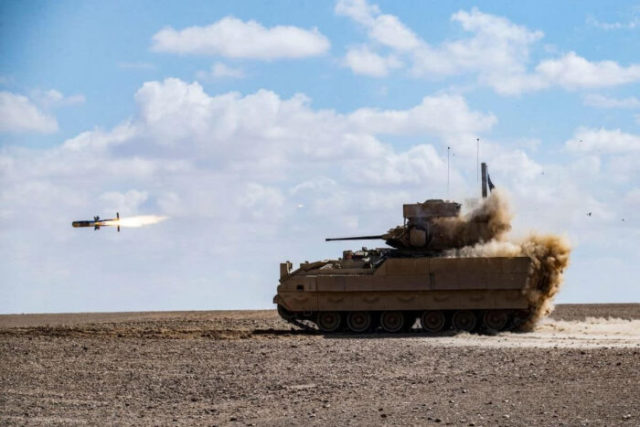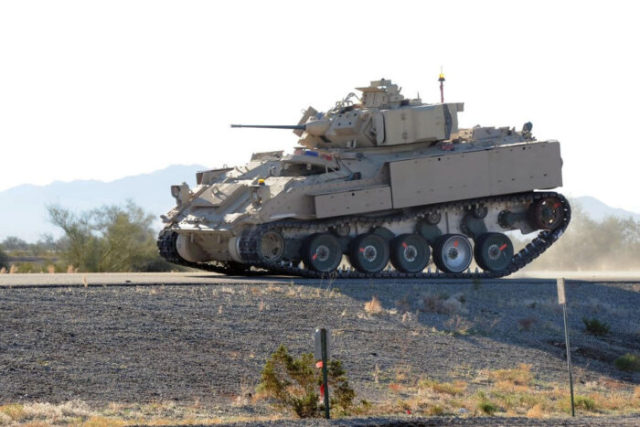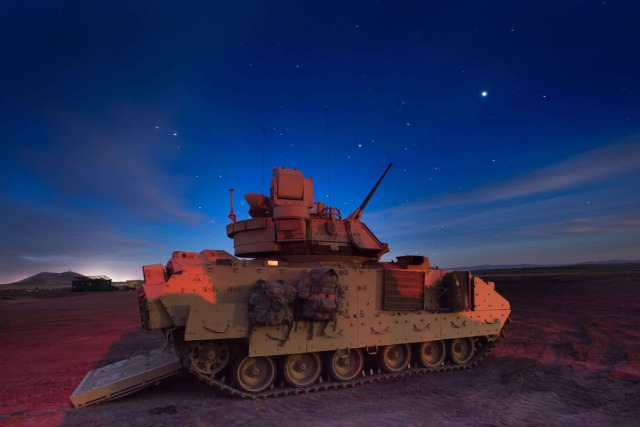At the end of June 2023, the US Army announced that two of the five teams that were asked to submit detailed replacement options for thousands of American M2 Bradley BMPs from 40 years ago had been selected. As you know, the Bradleys are currently undergoing a brutal baptism of fire in Russian minefields during the AFU counteroffensive.
Over the past 20 years, this is the fourth attempt by the US Army to purchase a replacement for the Bradley. The most recent, optionally manned Combat Vehicle ( OMFV ), was discontinued suddenly and dramatically in 2020. For the current iteration of the competition, the OMFV was eventually renamed the Mechanized Infantry Combat Vehicle XM30 – a return to the abbreviation of the 1960s.
It is planned that the XM30 will receive a much larger 50 mm automatic cannon, a smaller crew of two, a hybrid-electric motor that provides silent operation at idle, as well as systems for reducing signatures and active protection to increase survivability.
The US Department of Defense intends to spend another $1.6 billion. over the next three years, competing teams, General Dynamics Land Systems (GDLS) and American Rheinmetall (a subsidiary of the German concern), developed a digital design and, starting in 2025, physically assembled from seven to 11 prototypes of machines that will participate in the tests. In 2027, the US Army will choose the winner and begin purchases, and deliveries of the first combat units will begin in 2029. It is expected that the cost of purchasing an unspecified quantity of XM30 will amount to $45 billion.
According to sources, ironically, the finalists of the competition were the same two last teams from the third iteration, probably using the same basic constructions. However, this time the concept of the army has changed significantly in favor of a smaller vehicle carrying a smaller crew and troops in order to control the weight and at the same time achieve a higher density of armor. There also seems to be less focus on unmanned operations - at least in their initial configuration.
So, experts say, if this competition finally ends, the result will be cars different from those that were presented in 2020.
Odyssey of replacing the BMP M2 "Bradley"
It is believed that the BMP M2 "Bradley" is a class of military equipment that combines in battle some indicators of the firepower of the tank and the transport capabilities of the armored personnel carrier. As a result, the Bradley transports infantry and acts as a platform for anti-tank missiles and a rapid-firing 25 mm Bushmaster automatic cannon, which is lethal to enemy personnel and light armored vehicles.

ATGM launch from the Bradley
The current weight of the M2 Bradley is 30 tons – twice as much as its Soviet counterpart, the BMP-2 – which provides stronger armor against heavy machine guns, artillery fragments and automatic cannons.
Although the Bradley combat vehicle was very successful in the 1991 Gulf War, the Pentagon, after the end of the Cold War, believed that intense armored battles were a thing of the past, and wanted to create a much lighter family of vehicles. It was envisaged that this technique, known as the Combat system of the future (FCS), would rely on network communications and sensors to reduce warming.
The overly ambitious FCS program was canceled in 2009, spending $18 billion on it. By that time, combat experience in Iraq had convinced the army that heavy armored vehicles were actually still very useful for keeping soldiers alive. The second option to replace the BMP M2 "Bradley" — a ground combat vehicle (GCV) — swung the pendulum towards additional protection, which made it impractically excessive in weight and led to the cancellation of the project in 2014.
It was assumed that the third attempt, NGCV, or OMFV, would be more balanced. But the army demanded extremely fast development deadlines with inflexible requirements, scaring off industry interest. In the end, the army turned its back on two finalists, Griffin III from General Dynamics and Lynx KF41 from Rheinmetall, disqualifying the latter due to delays in obtaining permission to transport the prototype for evaluation and rejecting the former because it was too large and heavy.
The competition was resumed in 2020 with the intention of offering the industry a more flexible and unhurried approach. In 2021, five teams — Rheinmetall, GDLS, Oshkosh and South Korea's Hanwha, BAE Systems and Point Blank Enterprise (best known for body armor) — received $300 million to develop proposals. Oshkosh and Hanwha jointly developed a concept based on the latest K-21 BMP, and BAE Systems proposed the evolution of the AMPV tracked SUV based on the Bradley.
Big guns are in fashion
It is reported that the XM30 variant will retain tracks for cross-country movement and will become heavier than the M2 Bradley BMP due to the increased level of protection. However, the weight and dimensions of the vehicle should still allow carrying two IFVs in one C-17 military transport aircraft. To this end, the army settled on a design that allows only six soldiers to lead into battle, with a crew reduced from three to two people thanks to automation: a commander/driver and a remote-controlled turret gunner.
Currently, the mechanized platoons of the US Army are three squads of nine infantrymen, awkwardly distributed among four M2 Bradley infantry fighting vehicles with a capacity of seven infantrymen each. When asked if the squads of 6 people are at risk of being too small, British armored vehicles expert Nicholas Drummond noted that platoons with 6 infantry fighting vehicles are expected. Acting in pairs, they will be able to transport three dismounted squads of 12 infantrymen. He also added that the requirement for the C-17 "assumes a maximum combat weight of 42.4 tons."
It is noted that the XM30 debuts with the possibility of autonomous movement between waypoints on the map. At the same time, the appearance of combat capability without a crew is expected later – if it ever appears at all. Software for vehicles designed for uninterrupted interaction with friendly sources will begin to be developed separately from the machine itself in 2024-2025.

50 mm automatic cannon XM913
The main weapon of the XM30 will be the XM913 automatic cannon of 50 mm (2 inches) caliber with automatic loading of shells and a rate of fire of 200 rounds per minute. This is twice the size of the current 25 mm M2 Bradley cannon, but each shell is many times larger in weight and volume.
The effective range of hitting armored targets with the XM913 is 2.5 miles (4 km), and softer ones – up to 4.3 miles (about 7 km), while the effectiveness of each shot is much higher. In addition to armor-piercing sub-caliber shells, the XM1203 cannon can use explosive XM1204 shells against infantry. The latter can be programmed either to explode in the air in order to shoot down drones and threaten infantry in trenches, or – after breaking through the wall of the structure.
Like the Bradley, the XM30 will also retain a machine gun and ATGM to fight heavy tanks and possibly low-flying helicopters at long range.
Noiselessness and security
Another significant change in the XM30 project is related to the use of a hybrid electric motor, which will allow the car to idle without noise and fuel consumption and, presumably, support more energy-intensive systems.
While the DoD's emissions reduction goals may affect the demand for hybrid powerplants, they also have potential operational advantages in fuel logistics and acoustic stealth. This is consistent with the army's broader focus on "reducing the visibility" of the XM30. This probably implies the use of coatings, armor materials, thermal ventilation pipes or camouflage systems to reduce or distort the thermal/infrared visibility of the combat vehicle. According to Western experts, with reference to Ukrainian sources, such measures used on Russian tanks have proven their combat effectiveness. In addition, it is possible to search for means to reduce radar and electromagnetic signatures.

Tests of the BMP M2 "Bradley" with an "improved undercarriage" with adjustable ground clearance. Yuma Army Training Ground January 2020.
For protection after detection, the XM30 provides for an integrated active protection system that detects approaching projectiles using radar and automatically hits them before they reach the vehicle. Additionally, the use of multispectral smoke grenades is being designed to hide the vehicle from the operators of anti-tank weapons and laser designators.
In addition, it is possible to add armor with an application, "providing the basic level of protection of a battle tank." In other words, in the field, the XM30 can be equipped with additional heavy armor or active armor elements to increase survival in high-risk conditions, without weighing it down during training, transit or low-intensity operations.
The XM30 model can also be equipped with a device for storing, launching and recharging small unmanned aerial vehicles, which have proved extremely useful in Ukraine for detecting an enemy hidden in shelters.
Looking to the future, the U.S. Army wants the XM30 to support modular mission packages and retain space to install additional systems for 40-50 years of service. Regarding the previous M113 APC and M2 Bradley BMP, there is a high probability of creating an "ecosystem" of specialized variants based on the XM30, which will include reconnaissance, anti-tank, anti-aircraft, engineering, recovery vehicles, medical evacuation and combat control.
The XM30 variant is also designed for export, increasing the user base and thereby improving the scaling effect. In addition, the US Army is considering the use of predictive maintenance technology using artificial intelligence to reduce operating costs.
To be continued …
According to the materials ресурсаpopularmechanics.com

